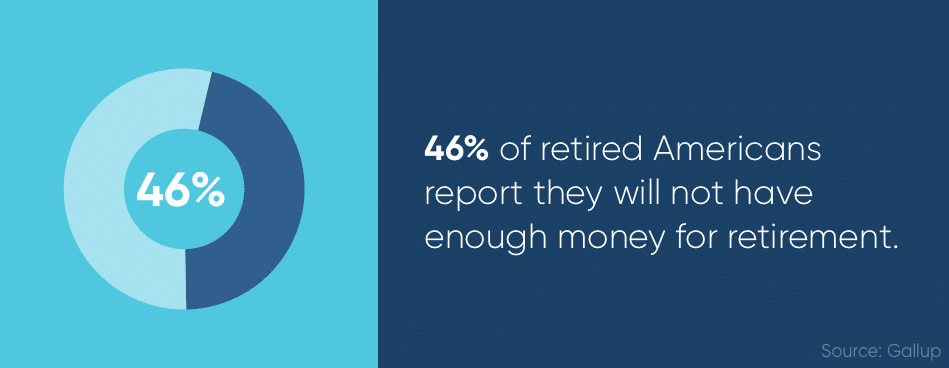As you near retirement, you may feel anxious about leaving the workforce and relying on your ongoing retirement Income streams and savings to fund your basic necessities and lifestyle. Especially anxiety-inducing is the advice around what you should have saved for retirement: traditionally $1 million to $1.5 million. According to Gallup.com, 46% of retired Americans report they will not have enough money for retirement.
With numbers like these floating around, it’s no surprise that many older Americans have concerns around the financial uncertainties that can crop up around retirement age.
Today, we’ll unravel the top retirement fears seniors have surrounding retirement and how to successfully navigate these anxieties by using savings and cash flow strategies to properly prepare.
Here are the top retirement concerns reported by seniors and what you can do to keep your worries at bay:
Retirement Concern #1: A sudden emergency
Even if you feel comfortable with the amount you have saved for retirement, an emergency can put a strain on even the most robust savings account. An emergency could be a sudden death of the main breadwinner of the family, forced retirement, or a natural disaster. Whether or not you’re prepared for it, the worse-case-scenario sometimes does happen. The question becomes, are you financially ready to weather an emergency?
Creating an emergency savings fund is a great way to prepare for the unexpected, especially if you don’t want to start taking money out of your main retirement nest egg.
Outside of retirement, financial experts recommend saving 3-6 months’ worth of expenses while you’re working. You might be surprised to learn that only 40% of Americans reported having enough money to cover a $400 emergency so learning to save while you’re still working is a good goal achieve.
But during retirement, it’s recommended that you increase that number to 12-18 months to anticipate the changes in your lifestyle and differences in expenses. For example, while your car loan and student loan could be completely paid off, you might see increases in expense categories like travel and health care during retirement.
To create a fund that reflects a realistic amount of your monthly expenses, you’ll want to accurately track where your money goes each month. This list could include:
- Housing expenses
- Entertainment and hobby costs
- Food and grocery expenses
- Utilities such as electricity bills, water, trash, etc.
- Transportation like gas, bus passes, etc.
- Debt payments
- Health care
- Insurance premiums
- Travel
- Other miscellaneous costs
Again, your target emergency fund amount will be specific to you. Take the time to go over your monthly expenses with a fine-tooth comb so you can parse out where you actually spend money. If your expenses are around $3,000 every month, for example, your emergency fund should be between $36,000 to $54,000 in retirement.

Retirement Concern #2: Surprise medical expenses
Another major concern for retired Americans is unexpected medical expenses. While you might be healthy at the moment, you can’t predict how that will change in the future. It’s best to prepare ahead of time so you’ll have extra cash on hand to deal with expenses not covered by your health plan.
For the average couple retiring today at age 65, $280,000 is required to cover healthcare and medical costs in retirement. As you grow older, so does the likelihood you’ll need more medical care and Medicare likely won’t cover all the costs of healthcare you may need in the future.
There are a few ways to prepare so you can successfully manage your health costs as you get older. One possible strategy is using an HSA or health savings account. The money in an HSA is both tax-deductible and tax-deferred. In addition, if you end up using the money in the account you can spend it on medical costs with no tax incurred.
Another option is to enroll in a Medicare Supplement plan since traditional Medicare only covers a portion of your healthcare expenses. A supplement plan may help you bridge the gap between what’s covered and what’s not so less money is coming out of pocket.
Retirement Concern #3: Not having enough money to retire
For many seniors, a lack of adequate funds is a serious fear. The amount you’ll need to save for retirement is dependent on your standard of living, your hobbies, travel plans, and other factors that may influence your financial life.
One way to mitigate the risk of not having enough money to retire is looking into reverse mortgage benefits to provide you with a new source of cash flow.
Curious how this financial product works? A reverse mortgage loan allows eligible retirees to convert the equity they have in their homes into usable cash.
In order to qualify for a reverse mortgage, you’ll need to meet a few conditions:
- Be 62 years of age or older
- Own substantial equity in your home
- Live in your home permanently
The proceeds from a reverse mortgage can be disbursed in the form of a line of credit, a lump sum, or a combination of those two options. The funds can be used however you like and may help you age in place or provide you with the money you want to pursue new hobbies acquired in retirement. And you don’t have to pay back the loan during your lifetime.
To learn about how much money you may be able to get from a reserve mortgage, use this reverse mortgage calculator to get an estimate of your loan amount.
Getting Started with Reverse Mortgages
If you’re looking to get started with a reverse mortgage, these articles can help guide you through all aspects of the process.
Guide to HECM Loan Reverse Mortgage Limits
Retirement Concern #4: Outliving my retirement savings
Another retirement challenge is outliving your retirement savings – nobody wants to pinch pennies after years of hard work and saving.
There’s no hard number that works for everyone but it’s a general rule of thumb to have a goal of replacing about 70% of your annual pre-retirement income. Again, the final number that’s right for you depends on any number of variables like where you’ll live and your health, just to name two factors that may influence your finances.
To accomplish your retirement income goal, you can use a variety of approaches, but your general strategy should be based around three pillars of retirement income planning: sources of guaranteed income, the potential for your financial assets to grow, and built-in flexibility.
- Guaranteed income can be revenue and proceeds from Social Security, pensions, and annuities.
- You can ensure your money saved for retirement has the potential for growth by creating a portfolio defined by a mix of bonds, cash, and stocks that reflects your time horizon, risk tolerance, and the circumstances of your current finances.
- Remember, a portfolio that’s too aggressive creates unnecessary risk for you and your savings. But, on the other side of the coin, a portfolio that is too conservative might mean you’re missing out on the opportunity to grow your wealth. It’s in your best interest to hire a financial planner to find an approach that is best suited to your situation..
- And finally, it’s important to ensure you have built-in flexibility in your retirement portfolio. By relying on a diverse mix of income sources, you can better weather changes in your retirement.
By using a solid retirement income plan and starting to save early, you can help ensure that you don’t outlive your savings.

Retirement Concern #5: Becoming a burden financially
For many older parents, one of their top fears is relying on the generosity of their children to get through retirement. Luckily, there are changes you can implement early on to help reduce the risk of needing outside financial help.
Besides the points we’ve mentioned already like managing a diverse retirement income portfolio, creating an emergency fund, and putting money away in an HSA or adding a supplemental Medicare plan, you can also practice safe withdrawal methods to extend your money.
Experts recommend a 3-4.5% withdrawal rate each year as you start to draw down your investment portfolio and savings in retirement. Ideally, you’ll follow a logical order when you begin using your savings. For instance, you may want to start with taxable accounts first and then move on to your tax-free and tax-deferred investment accounts or 401(k). And then finally, tap into your tax-free Roth IRA account (if you have one) to allow the money in those accounts a chance to grow.
This will help maximize your income and extend the life of your savings in retirement. Again, it is a good idea to meet with a financial advisor who can provide expert advice for your particular financial situation.
Assuaging retirement concerns, one strategy at a time
As a senior, it can be a little intimidating finally making the decision to start your retirement and being unsure about your retirement income. However, by implementing retirement savings strategies early on and being realistic about your retirement income goals, you can avoid the top concerns and enjoy a comfortable retirement. If you’re interested in learning more about your reverse mortgage eligibility to help you make the most out of your retired years, you can get into contact with one of our Reverse Mortgage Specialists to see how a reverse mortgage can provide the advantage you need.

 1-866-840-0279
1-866-840-0279


